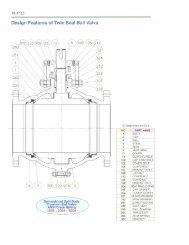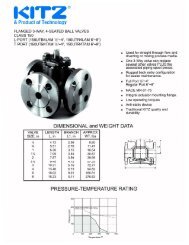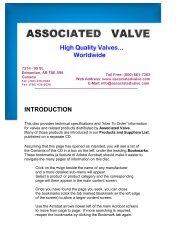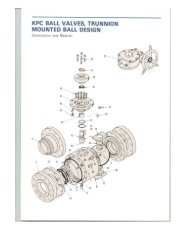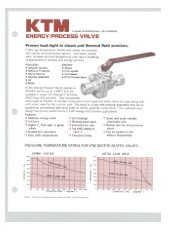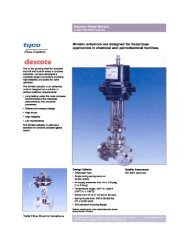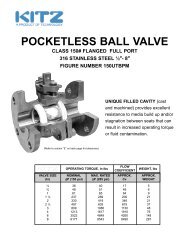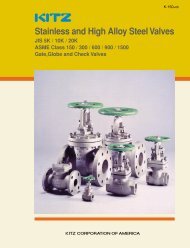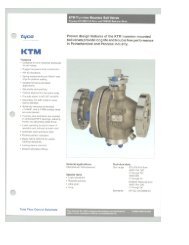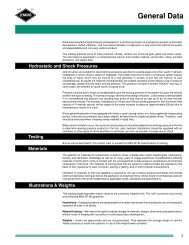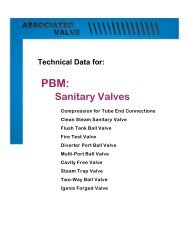Checkrite Valves - Associated Valve
Checkrite Valves - Associated Valve
Checkrite Valves - Associated Valve
You also want an ePaper? Increase the reach of your titles
YUMPU automatically turns print PDFs into web optimized ePapers that Google loves.
The Rite Advantages<br />
CHECK RITE SEATS Zero leakage shut off, even at 0 psi, is achieved<br />
through lapped metal seating surfaces. The seat and the disc edges<br />
are precisely machined then hand polished for a perfect fit. The disc<br />
hinge provides an even force at the disc to seat contact point, ensuring<br />
a uniform seal. Controlled tolerances maintain the proper disc to<br />
seat alignment. The spring assisted closure tension holds the disc in<br />
place when line pressure is removed.<br />
RESILIENT SEATS A dynamic, O-ring seat is contained in a specially<br />
designed body groove. As line pressure is applied, the valve disc uniformly<br />
compresses the seat into the groove ensuring a zero leakage<br />
seal. The seat is easily replaced, simplifying maintenance.<br />
METAL-TO-METAL SEATS Integral metal seats feature an engineered<br />
and precision machined angle that minimizes the metal-to-metal<br />
contact point between the disc and seat for a perfect seal. Pressure is<br />
applied evenly over the disc, eliminating galling and reducing wear.<br />
METAL SEAT INSERT Carbon steel and ductile iron bodies have a<br />
stainless steel seat inserted into the body seal area, offering the same<br />
precision design as the integral metal-to-metal seat. These bodies are<br />
also available with a Resilient Seat Insert.<br />
INHERENTLY FIRE SAFE All Check Rite valves are inherently fire<br />
safe due to the valve design, materials and construction. In the event<br />
of a pipeline fire, both resilient seated and metal seated valves provide<br />
metal-to-metal contact between the seat and disc and surpass all leak<br />
test standards.<br />
Pressure Drop with Water<br />
<strong>Valve</strong><br />
Size<br />
Cv<br />
Min Flow To Approx<br />
Fully Open Pressure<br />
<strong>Valve</strong> Drop<br />
w/Water<br />
Inch / mm GPM Ft/sec. PSI<br />
1 / 25 30 28 10.4 0.78<br />
1.5 / 40 38 68 10.7 2.1<br />
2 / 50 84 46 4.4 1.7<br />
2.5 / 65 137 76 5.1 1.4<br />
3 / 75 221 197 8.5 1.1<br />
4 / 100 373 157 4 1.4<br />
5 / 125 679 352 5.6 1.1<br />
6 / 150 931 367 4.1 1.5<br />
8 / 200 1,440 428 2.7 1.6<br />
10 / 250 2,623 837 3.4 1.1<br />
12 / 300 3,531 1,229 3.5 1.2<br />
14 / 350 3,226 1,180 2.7 2<br />
16 / 400 3,911 1,447 2.5 2.6<br />
18 / 450 5,799 3,376 4.8 1.7<br />
20 / 500 7,769 6,500 6.3 1.5<br />
24 / 600 10,105 8,321 5.9 1.6<br />
28 / 700 14,100 9,250 5.3 1.5<br />
30 / 750 18,041 10,303 5.1 0.9<br />
32 / 800 20,900 12,150 5.0 1.4<br />
36 / 900 25,675 15,850 5.2 2<br />
40 / 1,000 39,340 25,310 6.1 2.4<br />
42 / 1050 47,914 31,304 7.5 2.7<br />
48 / 1200 44,983 33,095 5.9 1.6<br />
54 / 1350 63,000 45,000 6 .9<br />
60 / 1500 70,500 62,800 6.2 1.1<br />
Notice the full open stable minimum velocity and the<br />
efficiency calculated at a normal velocity of 10 f/sec.<br />
Resilient Seat<br />
Metal-To-Metal Seat<br />
Metal Seat Insert<br />
The convex profile of<br />
the disc reacts to line<br />
flow like an airfoil. The<br />
velocity above the disc is<br />
higher than the velocity<br />
below, thus effectively<br />
creating lift.<br />
4



